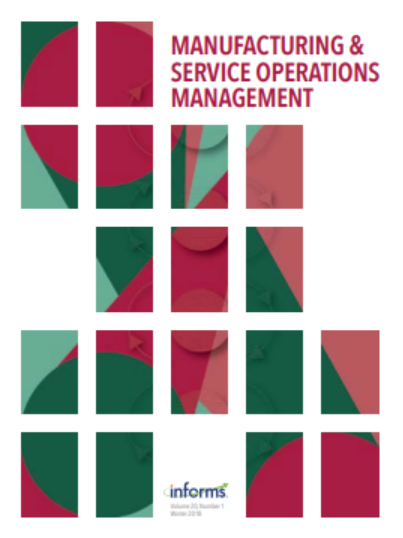Disclosing Product Availability in Online Retail
IF 4.8
3区 管理学
Q1 MANAGEMENT
M&som-Manufacturing & Service Operations Management
Pub Date : 2023-03-01
DOI:10.1287/msom.2020.0882
引用次数: 17
Abstract
Problem definition: Online retailers disclose product availability to influence customer decisions as a form of pressure selling designed to compel customers to rush into a purchase. Can the revelation of this information drive sales and profitability? We study the effect of disclosing product availability on market outcomes—product sales and returns—and identify the contexts where this effect is most powerful. Academic/practical relevance: Increasing sell-out is key for online retailers to remain profitable in the presence of thin margins and complex operations. We provide insights into how their information-disclosure policy—something they can tailor at virtually no cost—can contribute to this important objective. Methodology: We collaborate with an online retailer to procure a year of transaction data on 190,696 products that span 1,290 brands and 472,980 customers. To causally identify our results, we use a generalized difference-in-differences design with matching that exploits one policy of the firm: it discloses product availability only for the last five units. Results: The disclosure of low product availability increases hourly sales—they grow by 13.6%—but these products are more likely to be returned—product return rates increase by 17.0%. Because returns are costly, we also study net sales—product hourly sales minus hourly returns—which increase by 12.5% after the retailer reveals low availability. Managerial implications: The positive effects on sales and profitability amplify over wide assortments and when low-availability signals are abundantly visible and disclosed for deeply discounted products whose sales season is about to end. In addition, we propose a data-driven policy that exploits these results by using machine learning to prescribe the timing of disclosure of scarcity signals in order to boost sales without spiking returns. History: This paper has been accepted as part of the 2019 Manufacturing & Service Operations Management Practice-Based Research Competition.在线零售中披露产品可用性
问题定义:在线零售商披露产品的可用性,以影响客户的决定,作为一种压力销售的形式,旨在迫使客户急于购买。这些信息的披露能否推动销售和盈利?我们研究了披露产品可用性对市场结果(产品销售和退货)的影响,并确定了这种影响最强大的环境。学术/实践意义:在利润微薄和运营复杂的情况下,提高售罄率是在线零售商保持盈利的关键。我们提供了他们的信息披露政策(他们可以在几乎没有成本的情况下进行调整)如何有助于实现这一重要目标的见解。方法:我们与一家在线零售商合作,获取190,696种产品的一年交易数据,涉及1,290个品牌和472,980名客户。为了确定我们的结果,我们使用了一种通用的差异中差异设计,该设计利用了公司的一项政策:它只披露了最后五个单位的产品可用性。结果:低可用性产品的披露增加了每小时的销售额——他们增长了13.6%——但这些产品更有可能被退货——产品退货率增加了17.0%。由于退货成本很高,我们还研究了净销售额——产品每小时销售额减去每小时退货——在零售商披露低可用性后,净销售额增加12.5%。管理意义:对销售和盈利能力的积极影响在广泛的分类中被放大,当低可用性信号非常明显时,销售季节即将结束的大折扣产品就会被披露。此外,我们提出了一种数据驱动的策略,通过使用机器学习来规定披露稀缺信号的时间,从而在不增加回报的情况下促进销售,从而利用这些结果。历史:本文已被接受为2019年制造业&服务营运管理实务研究比赛。
本文章由计算机程序翻译,如有差异,请以英文原文为准。
求助全文
约1分钟内获得全文
求助全文
来源期刊

M&som-Manufacturing & Service Operations Management
管理科学-运筹学与管理科学
CiteScore
9.30
自引率
12.70%
发文量
184
审稿时长
12 months
期刊介绍:
M&SOM is the INFORMS journal for operations management. The purpose of the journal is to publish high-impact manuscripts that report relevant research on important problems in operations management (OM). The field of OM is the study of the innovative or traditional processes for the design, procurement, production, delivery, and recovery of goods and services. OM research entails the control, planning, design, and improvement of these processes. This research can be prescriptive, descriptive, or predictive; however, the intent of the research is ultimately to develop some form of enduring knowledge that can lead to more efficient or effective processes for the creation and delivery of goods and services.
M&SOM encourages a variety of methodological approaches to OM research; papers may be theoretical or empirical, analytical or computational, and may be based on a range of established research disciplines. M&SOM encourages contributions in OM across the full spectrum of decision making: strategic, tactical, and operational. Furthermore, the journal supports research that examines pertinent issues at the interfaces between OM and other functional areas.
 求助内容:
求助内容: 应助结果提醒方式:
应助结果提醒方式:


